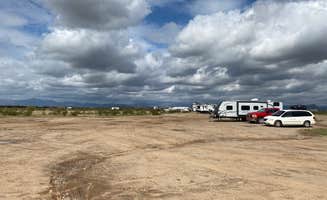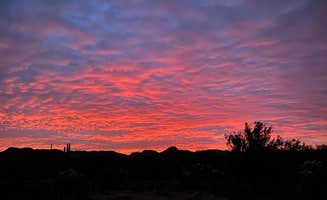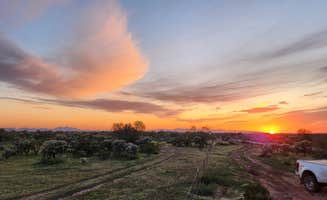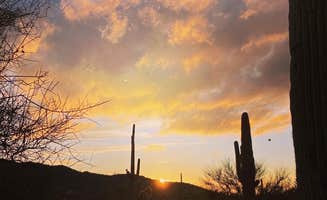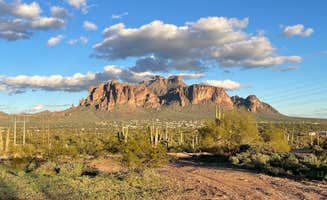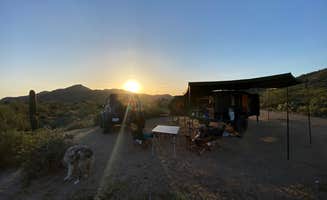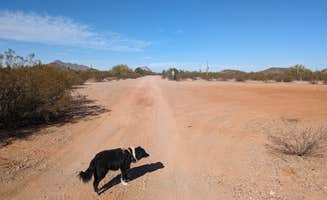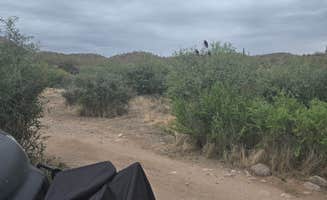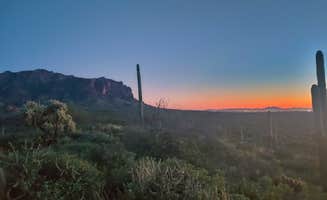Dispersed camping opportunities near Coolidge, Arizona encompass both rugged desert terrain and mountain landscapes with elevations ranging from 1,600 to 3,000 feet. The camping season extends year-round, though summer temperatures regularly exceed 105°F between June and August. Most access roads require moderate ground clearance with deeper areas demanding 4WD capability.
What to do
Mountain biking on desert trails: Cottonwood Canyon Rd. Dispersed offers access to numerous riding paths. "Great trails! Big rig friendly boondocking. Busy dirt road, as there is an active mine off the road," notes Casey G. The area connects to Box Canyon trails for more advanced riders.
Target shooting areas: While shooting occurs throughout the region, designated sites exist away from campgrounds. "We were actually a bit south of this... This is on AZ State Trust land and a permit is required," explains Chantal S. about properly designated shooting zones near Cottonwood Canyon.
Wildlife observation: Dawn and dusk offer prime viewing times for desert wildlife. "Camp was raided by quail early in the morning and we had some cows visit but they didn't come too close," shares Sammy S. Desert tortoise sightings occur primarily February through April.
What campers like
Proximity to Phoenix metro: BLM Ironwood Forest National Monument provides accessible free camping near Coolidge, Arizona with reasonable driving times. "Easy to find- road isn't too bad. Was quiet, breezy- and just what we were looking for," notes Timber.
Desert night temperatures: Even during hot months, overnight lows drop significantly. "We really enjoyed driving through this area at sunset and seeing all the iconic cactus," reports Rocco from Cactus Forest Dispersed. Temperature differentials of 30-40 degrees between day and night are common.
Spacious campsites: Most areas offer generous spacing between sites. "The cactuses and shrubs provided enough privacy between each site for it to feel like it was just us out there, and shielded us from the road as well," says Suzie K. about the natural spacing at Cactus Forest.
What you should know
State Trust Land permits: Several camping areas require Arizona State Trust Land permits ($20 annual family pass). "We were shocked to see all access except to the park and trailhead are closed. I agree a few camping spots were over used but that shouldn't have closed the whole area," warns Greg H. about Peralta Road Dispersed Camping.
Cactus hazards: Vegetation threats require careful site selection. "My only advice here is that it's not fun for dogs. (And maybe not fun for kids either?) It's incredibly prickly everywhere," cautions Rocco. Tools for removing cactus spines are essential camping gear.
Traffic patterns: Mining operations affect some camping areas with truck noise. "Starting at 4:00am...giant, and i mean GIANT rock hauler semi trucks started barreling down the washboarded road every 5-10 minutes until we packed up and left a day early," reports Eric W.
Tips for camping with families
Plant identification activities: The Sonoran Desert offers distinctive plant species to learn. "Absolutely beautiful landscape to walk around with Saguaros and Chollas everywhere. Watch out for cactus pieces on the ground when you drive in!" advises Suzie K.
Avoid cholla-dense areas: Ironwood Forest BLM requires careful site selection with children. "Beware of teddy bear cholla cactus! They are everywhere, grab right onto you if you brush them gently by accident. Very painful to get out," warns Taylor.
Morning wildlife viewing: Schedule animal observation early. "We camp wit a TT and had a great time," reports Jeffrey P. from Cottonwood Canyon. "Camped off cottonwood this weekend. Great weather and good area," adds Ryan, noting good early morning wildlife activity.
Tips from RVers
Road washboarding assessment: Cactus Forest Dispersed - High Clearance requires careful vehicle matching to road conditions. "Narrow Road in will scratch your vehicle, but it is quiet and the sides are level," reports Jim H. Road conditions deteriorate dramatically after rain.
Leveling blocks requirement: Many sites have natural slopes requiring additional leveling equipment. "After we got the rig into position, I had to level out some spots with a shovel so the jacks and our blocks would be level when the rig's weight was on them," explains Will and Lucinda B.
Dust management: Site positioning should account for prevailing winds and road dust. "Can get dusty from riders if you stay near the front. If you take some time to come scout it out you can find some great spots," advises Steve T. from Cottonwood Canyon, recommending positioning at least 200 feet from main roads.


